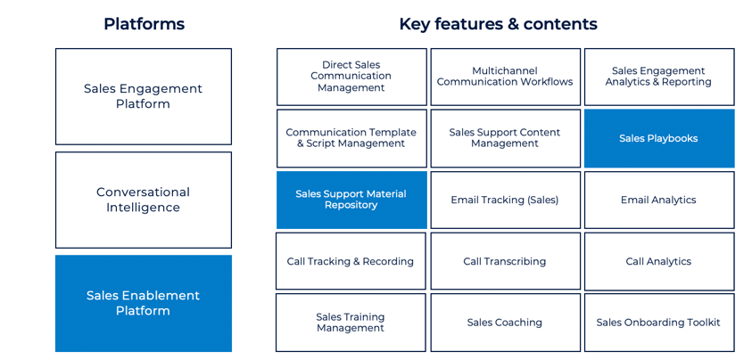Over the years we've see many large organisations experience a disconnect between sales and marketing teams, struggling to keep activities between both functions aligned. Marketing and sales teams and stakeholders sometimes have relatively little contact, failing to share with each other up-to-date content and insights on what resonates with their customer audiences, or even what benefits and messages most often help close a deal.
Managing and sharing the large amount of content that comes from both marketing and sales teams presents an especially common challenge.
For instance, marketing teams often put a lot of time and effort into producing great marketing collateral that their sales counterparts never see – e.g. case studies, customer testimonials, product and solution overviews. Similarly, sales teams will often develop their own material and gain valuable insight into which assets and messages really work at specific stages of the buying journey, insights that never reach their marketing colleagues. One of the most effective methods of maximising marketing and sales alignment is to develop a sales playbook.
Bridging the gap
A sales playbook (also sometimes referred to as a "saleskit", or "sales toolkit") focuses on sales enablement by supporting sales teams with content and guidance produced by marketing. In doing so, the playbook tackles the challenges of providing tools, content, and functionality that enable your sales team to: 1) share higher quality content with customers, 2) react quickly to leads and prospects following pre-defined processes, and 3) gain added insights on exactly which content resonates best with your audience.
There are a wide variety of solutions and platforms out there that address various aspects of sales engagement, conversational intelligence, and sales enablement – providing a breadth of functionality and capabilities depending on what your core use cases and requirements are.
That said, we’ve found that when starting out it’s important to focus your efforts on areas and opportunities that drive better collaboration between marketing and sales teams. We recommend focusing on two areas. Firstly, on providing sales teams with a repository of material and collateral, and secondly on providing curated content on guidance and best practices related to the sales process.

Multiple studies, for example one from the Aberdeen Group [1], have found that organisations that use a sales playbook to provide clear guidance and material to sales teams see an 8% lift in the attainment of targets by individual team members.
But where does this increased performance come from? Let’s investigate.
The proven benefits of using a sales playbook
Numerous studies over the years have found that sales representatives only spend around 1/3 of selling and a significant amount of their time either can be spent searching for or creating collateral that they can send to customers. [2]
Sales playbooks are a great place to start when trying to drive improved alignment between marketing and sales because it can serve as the shortest route to tangible results by connecting the dots between your teams.
Two of the easiest dots to connect are 1) to leverage existing marketing material as part of your sales process, and 2) provide guidance from sales leadership and stakeholders on how to execute a structured process during sales operations and lead management. These efforts can then quickly pay off by:
- Reducing the amount of time your sales team spends searching for or creating sales collateral.
- Ensuring up-to-date sales and marketing content is available to support the sales process when it's needed most.
- Reducing the amount of content that gets produced only to remain unused.
- Enabling quicker follow-up by providing easily shareable sales content.
- Measuring sales content performance by measuring content engagement during the sales process
As discussed, when trying to make inroads on driving better alignment between your sales and marketing teams there are a number of areas and specific capabilities you can look to focus on. Sales playbooks are one, and what we've discussed here are just some of the ways a playbook can help drive value.
If you're considering how to maximise alignment between your sales and marketing teams, and think that a sales playbook might be a solution, let’s talk!
[1] Aberdeen Group, Moving the Needle on Sales Productivity: Success Goes Mobile
[2] Hubspot, Salespeople Only Spent One-Third of Their Time Selling Last Year





